 Crown Castle International announced today that it has formed a new subsidiary, Crown Castle Mobile Media, tasked with delivering live mobile television services to handheld devices including cell phones.
Crown Castle International announced today that it has formed a new subsidiary, Crown Castle Mobile Media, tasked with delivering live mobile television services to handheld devices including cell phones.
Crown Castle Mobile Media intends to build and operate a dedicated digital network for broadcasting digital television content to PDAs, cell phones and other suitable devices.
The technology being used, Digital Video Broadcasting- Handheld (DVB-H), is currently expected to become the global standard for mobile television and has been formally adopted by both the DVB Organization and the European Telecommunications Standards Institute (ETSI).
Crown Castle and Nokia recently completed successful demonstration trials of this open-standard technology in Pittsburgh, Pennsylvania, with Crown Castle Mobile Media expecting to roll out a commercial deployment of this service in selected major US markets during 2005.
“Crown Castle owns over 10,000 wireless towers and holds a nationwide spectrum license,” commented John P. Kelly, President and Chief Executive Officer of Crown Castle. “These valuable assets, combined with our proven expertise in digital broadcasting in the UK, provide a unique opportunity to take a leading position in the emerging mobile television market. We look forward to partnering with content providers and wireless services providers to introduce commercial services.”
Richard Sharp, vice president of Nokia’s Rich Media business unit added, “Nokia and Crown Castle broadcast mobile television for the first time in the US during live market trials that began in Pittsburgh last October and are working together to bring mobile television and radio to the hands of wireless users across the United States.
 Crown Castle’s support of DVB-H is further evidence that DVB-H is a robust, open standard that will not only bring high- quality television and radio to the market, but will ensure a vibrant marketplace for infrastructure equipment, innovative devices, and compelling services.”
Crown Castle’s support of DVB-H is further evidence that DVB-H is a robust, open standard that will not only bring high- quality television and radio to the market, but will ensure a vibrant marketplace for infrastructure equipment, innovative devices, and compelling services.”
Earlier this week, Crown Castle Mobile Media also announced that it will work together with Samsung Electronics to accelerate the provision of digital television services to handset devices in the US market.
Samsung will be the world’s first wireless phone manufacturer to launch DVB-H handsets supporting both WCDMA/EVDO and GSM/GPRS networks, providing entertainment-hungry consumers with quality, built-in television screens receiving real DVB-H streaming television and Radio channels.
Crown Castle Mobile Media enjoys an unencumbered nationwide US spectrum license and anticipates building a DVB-H network across the US to transmit high-quality, multi-channel live and streaming digital television for reception on suitably-equipped cell phones.
Samsung is developing premium handsets to work on the Crown Castle Mobile Media network, and have already showcased wireless phones with 2″ QVGA screens supporting 226k colors, up to 30 frames per second, and 300 kbit/s per channel speeds.
The phones have MPE-FEC error correction implemented and use the latest H.264 and AAC+ video/audio decoding technologies.
“Samsung is recognized as a global leader bringing to market multimedia technologies that enhance the way consumers are able to use and interact with their wireless phones,” said Dale Sohn, VP of Samsung’s Overseas Investment Group.
“We understand the value of working with companies like Crown Castle Mobile Media to develop cutting-edge solutions like DVB-H.”
Mr. Michael Schueppert, President of Crown Castle Mobile Media, was suitably chuffed, “We are very excited to have a world-class leader in multimedia mobile phones like Samsung to assist in driving these new services. This collaboration will put Samsung in a position to become a key handset supplier to Crown Castle Mobile Media’s anticipated Pittsburgh DVB-H customer trial.”
Crown Castle
Samsung
 Commuters on London’s Tube network could soon be able to bellow out, “I’M ON THE TUBE!” if trials to introduce mobile and wireless Internet connections underground from 2008 get the green light.
Commuters on London’s Tube network could soon be able to bellow out, “I’M ON THE TUBE!” if trials to introduce mobile and wireless Internet connections underground from 2008 get the green light. LU director of strategy and service development, Richard Parry commented, “The process we launch today is to start getting information from the market about how we could best provide a mobile phones service”.
LU director of strategy and service development, Richard Parry commented, “The process we launch today is to start getting information from the market about how we could best provide a mobile phones service”. An LU spokesman added “Passengers would like to have mobile coverage at Tube stations but they are less keen to have it on trains”.
An LU spokesman added “Passengers would like to have mobile coverage at Tube stations but they are less keen to have it on trains”. Xdrive has announced an expansion to their service that gives roaming consumers wireless access to their files through any Internet-connected cell phone, smart phone or handheld device.
Xdrive has announced an expansion to their service that gives roaming consumers wireless access to their files through any Internet-connected cell phone, smart phone or handheld device.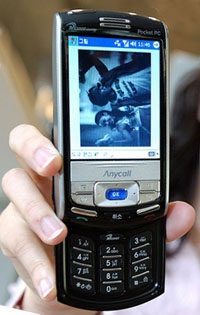 Samsung’s R&D team’s crack-like addiction to creating new products continues apace with the announcement of a new Wireless LAN Music Phone.
Samsung’s R&D team’s crack-like addiction to creating new products continues apace with the announcement of a new Wireless LAN Music Phone.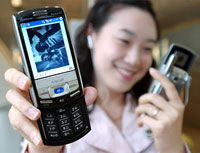 Sadly, there’s no QWERTY keyboard on the handset.
Sadly, there’s no QWERTY keyboard on the handset.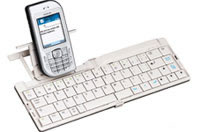 Incorporating not one, but two digital cameras (VGA on the front 1.3 megapixels to the rear), the handset was showcased a month ago at the 3GSM World Congress in Cannes.
Incorporating not one, but two digital cameras (VGA on the front 1.3 megapixels to the rear), the handset was showcased a month ago at the 3GSM World Congress in Cannes.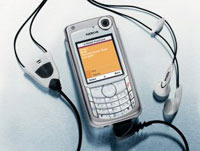 Mindful of the fact that trying to write long emails on a handset’s tiny buttons is as much fun as counting ants, Nokia have also announced their new SU-8W Wireless Keyboard.
Mindful of the fact that trying to write long emails on a handset’s tiny buttons is as much fun as counting ants, Nokia have also announced their new SU-8W Wireless Keyboard. European telco AB has announced that it’s launched the first worldwide free TV station available on 3G mobile phones, via its own TV channel Tango.TV (TTV).
European telco AB has announced that it’s launched the first worldwide free TV station available on 3G mobile phones, via its own TV channel Tango.TV (TTV). Thrill-seeking mobile phone users around the world slapped out US$400 million on pornographic pictures and video in 2004 – an amount that is expected to rise to US$5 billion by 2010, according to a report by research group Strategy Analytics.
Thrill-seeking mobile phone users around the world slapped out US$400 million on pornographic pictures and video in 2004 – an amount that is expected to rise to US$5 billion by 2010, according to a report by research group Strategy Analytics. The US$5 billion forecast for 2010 represents a huge upward shift from Strategy Analytics’ earlier predictions, with the company noting that adult entertainment businesses are aggressively building services and customers appear happy to shell out for them.
The US$5 billion forecast for 2010 represents a huge upward shift from Strategy Analytics’ earlier predictions, with the company noting that adult entertainment businesses are aggressively building services and customers appear happy to shell out for them. Crown Castle International announced today that it has formed a new subsidiary, Crown Castle Mobile Media, tasked with delivering live mobile television services to handheld devices including cell phones.
Crown Castle International announced today that it has formed a new subsidiary, Crown Castle Mobile Media, tasked with delivering live mobile television services to handheld devices including cell phones.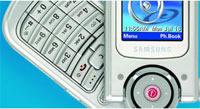 Crown Castle’s support of DVB-H is further evidence that DVB-H is a robust, open standard that will not only bring high- quality television and radio to the market, but will ensure a vibrant marketplace for infrastructure equipment, innovative devices, and compelling services.”
Crown Castle’s support of DVB-H is further evidence that DVB-H is a robust, open standard that will not only bring high- quality television and radio to the market, but will ensure a vibrant marketplace for infrastructure equipment, innovative devices, and compelling services.”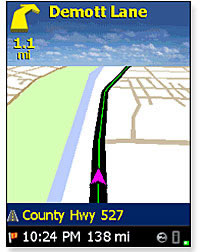 Motorola is to bundle GPS navigation software and hardware with the European versions of its A780 and MPx220 smart phones.
Motorola is to bundle GPS navigation software and hardware with the European versions of its A780 and MPx220 smart phones.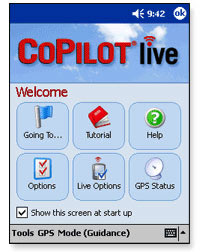 GPS navigation has proved a bit of a hit in Europe, with sales bolstering up an otherwise declining PDA market.
GPS navigation has proved a bit of a hit in Europe, with sales bolstering up an otherwise declining PDA market. Both handsets use Bluetooth to communicate with a separate GPS receiver.
Both handsets use Bluetooth to communicate with a separate GPS receiver. “The new IMAGEON processors from ATI combine advanced audio and video processing capabilities to turn mobile phones into mobile entertainment centers.”
“The new IMAGEON processors from ATI combine advanced audio and video processing capabilities to turn mobile phones into mobile entertainment centers.” Announced at the CeBIT tradeshow, Pretec have introduced a new memory card format for smartphones, called the C-Flash cards.
Announced at the CeBIT tradeshow, Pretec have introduced a new memory card format for smartphones, called the C-Flash cards.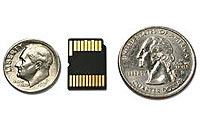 This format will also have support for MU-Card, a specification from China lead by Mu-Card Alliance. C-Flash has been adopted as the next small form factor version of MU-Card (called MU-Flash).
This format will also have support for MU-Card, a specification from China lead by Mu-Card Alliance. C-Flash has been adopted as the next small form factor version of MU-Card (called MU-Flash).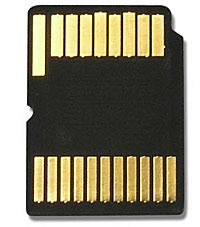 C-Flash has also been submitted to the MMC Association to be considered as the next small form factor standard of MMC.
C-Flash has also been submitted to the MMC Association to be considered as the next small form factor standard of MMC.